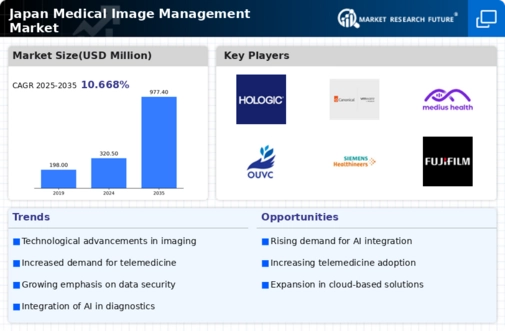Rising Demand for Diagnostic Imaging
The medical image-management market in Japan is experiencing a notable increase in demand for diagnostic imaging services. This trend is driven by an aging population, which is projected to reach 36.2% of the total population by 2040. As the prevalence of chronic diseases rises, healthcare providers are increasingly relying on advanced imaging technologies to enhance diagnostic accuracy. The market is expected to grow at a CAGR of approximately 8.5% from 2025 to 2030, indicating a robust expansion. This growth is likely to be fueled by investments in state-of-the-art imaging equipment and software solutions that improve workflow efficiency. Consequently, the medical image-management market is positioned to play a crucial role in supporting healthcare systems in Japan, ensuring timely and accurate patient diagnoses.
Increased Focus on Patient-Centric Care
The medical image-management market in Japan is increasingly aligning with the shift towards patient-centric care. Healthcare providers are recognizing the importance of involving patients in their diagnostic processes, which has led to the development of more user-friendly imaging technologies. This trend is likely to enhance patient satisfaction and engagement, as individuals become more informed about their health conditions. Furthermore, the market is witnessing a rise in demand for mobile imaging solutions that allow for greater convenience and accessibility. By 2026, it is estimated that the patient-centric segment of the medical image-management market could account for over 30% of total market revenue. This shift underscores the importance of adapting imaging services to meet the evolving expectations of patients in Japan.
Regulatory Framework Supporting Innovation
The regulatory framework in Japan is increasingly supportive of innovation within the medical image-management market. The Pharmaceuticals and Medical Devices Agency (PMDA) has streamlined approval processes for new imaging technologies, encouraging manufacturers to introduce cutting-edge solutions. This regulatory environment is conducive to research and development, fostering collaboration between healthcare providers and technology developers. As of 2025, it is anticipated that the number of approved imaging devices will increase by approximately 15% annually, reflecting a growing acceptance of innovative technologies. This supportive regulatory landscape is likely to drive the medical image-management market forward, enabling the introduction of advanced imaging solutions that enhance diagnostic accuracy and patient care.
Technological Advancements in Imaging Systems
Technological advancements are significantly influencing the medical image management market. Innovations such as 3D imaging, digital radiography, and advanced MRI techniques are enhancing the quality and speed of imaging services. The integration of cloud-based solutions is also facilitating better data management and accessibility. As of 2025, the market for digital imaging systems is projected to reach approximately $1.2 billion, reflecting a growing preference for high-resolution imaging technologies. These advancements not only improve diagnostic capabilities but also streamline workflows in healthcare facilities. The medical image-management market is thus evolving rapidly, driven by the need for more efficient and effective imaging solutions that cater to the demands of modern healthcare.
Growing Investment in Healthcare Infrastructure
Investment in healthcare infrastructure is a critical driver for the medical image-management market in Japan. The government has been actively promoting initiatives to modernize healthcare facilities, which includes upgrading imaging technologies. In 2025, public and private sector investments in healthcare are projected to exceed $50 billion, with a significant portion allocated to imaging systems. This influx of capital is expected to enhance the capabilities of medical institutions, allowing for the acquisition of advanced imaging equipment and software. As a result, the medical image-management market is likely to benefit from improved operational efficiencies and enhanced diagnostic services, ultimately leading to better patient outcomes.






















Leave a Comment